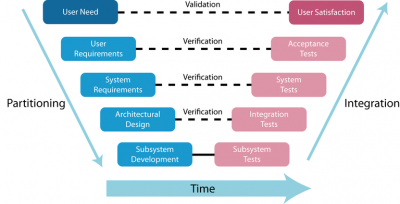The Systems Challenges
The International Council on Systems Engineering (INCOSE), defines Systems Engineering as "an interdisciplinary approach and means to enable the realization of successful systems. It focuses on defining customer needs and required functionality early in the development cycle, documenting requirements, then proceeding with design synthesis and system validation while considering the complete problem: Operations, Performance, Test, Manufacturing, Cost & Schedule, Training & Support, Disposal.
Systems Engineering integrates all the disciplines and
specialty groups into a team effort forming a structured development
process that proceeds from concept to production to operation. Systems
Engineering considers both the business and the technical needs of all customers with the goal of providing a quality product that meets the user needs" [INCOSE, 2004].
In System Integrity we consider what happens when finished components are ready to be integrated into assemblies and subsystems, and what needs to be done in order to achieve a robust system.
Integrity in Systems
A key element in the management and control of a systems
development is the knowledge of the baseline configuration at any point
within the process. The baseline refers to the configuration items
(CIs), the elements that constitute the system.
Configuration management is a process that is concerned
with identification, control and traceability of these baselines.
Effective configuration management is used to
ensure that the status
of each item is fully understood. A series of tests, variously called
verification, validation and/or acceptance tests, are carried out at
numerous levels. Testing of the product, or of individual parts of it,
can reveal faults that have to be corrected in a controlled way, and the
configuration management process assists in this as well.
The content and purpose of these tests will have been
defined beforehand in the earlier planning stages. Part of this planning
will determine which aspects of the product are to be tested in what
way - the test matrix. There is a balance to be found between the
thoroughness (and therefore cost) of the testing activities and the
desired quality of the product.
Integration and Verification
One of the most important tools for a systems engineer is the V-diagram, which is a
conceptual model of a system development lifecycle.

Most Systems Engineering processes include or incorporate at least one iteration of a V. Other life cycle diagrams can be drawn to show individual processes in greater detail, or to illustrate related activities. In this particular case we are concerned with the integration side of the diagram. This must not be taken as a reason not to consider integration issues in the early stages of development, but is intended as an aid to focus on the integration activities and the integrity of the system when they occur.
Learning from failure
Producing systems that deliver value to their stakeholders requires us to understand the ways in which systems may fail to perform as required. This module investigates in detail how we can estimate the probability and impact of system failure using techniques such as Failure Modes, Effects and Criticality Analysis (FMECA), Event Trees and Fault Trees.
It also discusses the concept of risk and variability in performance, and investigates ways in which we can anticipate failure by understanding both technological and human factors that may predispose a system to failure. Through the use of theory and in-depth case studies, we discuss how decisions are made and how system failure can result from poor individual or group decision making.
 Close
Close



